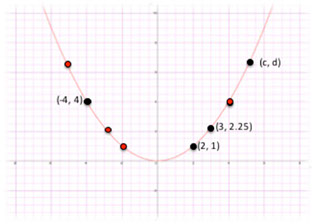Home
Episode 2 Supports
Episode Description
Exploring: Keoni and Sasha develop an equation for a parabola which has a vertex of (0,0) and distance of 2 units between the vertex and the focus. They use the Pythagorean theorem and the definition of a parabola.
Students’ Conceptual Challenges
Keoni initially thinks that the distance from a general point (x, y) on the parabola to the directrix will be y + 1 [1:04].
- Keoni quickly catches himself and realizes that when the distance between the vertex and the focus is 2 units (instead of 1 unit, as it was with the parabola that they worked with in Lessons 2-4), then the distance from the x-axis to the directrix will also be 2 units. Thus, the distance from (x, y) to the directrix will be y + 2.
- Keoni quickly catches himself and realizes that when the distance between the vertex and the focus is 2 units (instead of 1 unit, as it was with the parabola that they worked with in Lessons 2-4), then the distance from the x-axis to the directrix will also be 2 units. Thus, the distance from (x, y) to the directrix will be y + 2.
Focus Questions
For use in a classroom, pause the video and ask these questions:
1. [Pause video at 0:52]. Keoni has drawn two lines. What do you know about those two lines?
2. [Pause video at 3:50]. Solve for x. [Then start the video again and stop at 5:00]. How did your solution method compare with Sasha and Keoni’s?
Supporting Dialogue
Invite students to engage in revoicing (to say what they hear from someone else in their own words).
- In responding to the Focus Question 1, ask one student to revoice what another student said about the two lines.
- After the narrator has highlighted the meaning of the lengths that Sasha and Keoni found for the sides of their right triangle [2:09 – 3:28], call on different students to revoice the meaning of y+2, y–2 and x.
- In responding to the Focus Question 1, ask one student to revoice what another student said about the two lines.
Math Extensions
1. The equation y = x2/4 represents the parabola shown in red in the figure below. The coordinates for some points on the parabola are given. What do you notice about the red and grey points?

2. Find the coordinates for the red points in the graph above. Explain your reasoning.
Mathematics in this Lesson
Lesson Description
Targeted Understanding
CC Math Standards
CC Math Practices
Lesson Description
Keoni and Sasha determine a general method for representing the equation for a parabola with a vertex on the origin and a focus p units above the vertex.
Targeted Understandings
This lesson can help students:
- Interpret the meaning and use of an equation that they derive to represent a family of parabolas with vertex at the origin and focus p units above the vertex (y = x2/(4p)).
- Conceive of the parameter p in the equation y = x2/(4p) as a distance between the vertex and focus of a parabola. The value of p can vary, but once it is set (e.g., when p = 2), then an equation is defined (e.g., y = x2/8) that represents a unique parabola.
- Relate geometric features of parabolas to elements of corresponding equations. For example, the equation y = x2/8 can also be expressed as y = x2/(2•4), where the 2 represents the number of units between the focus and vertex of the parabola.
Common Core Math Standards
• CCSS.M.HSG.GPE.A.2: Derive the equation of a parabola given a focus and directrix.
In Episode 6, Sasha and Keoni derive the equation (in two forms) for the family of parabolas with vertex (0,0) and focus p units above the vertex, namely y = x2/(4p) and x = √(4py). They do this by generalizing the method they used to develop an equation for a parabola with p = 1 in Lessons 3 and 4 (y = x2/4 and x = √(4y)), for a parabola with p = 2 in Episode 2 of this lesson (y = x2/8 and x = √(8y)), and for a parabola with p = 3 in Episode 4 (y = x2/12 and x = √(12y)).
• CCSS.M.HSA.APR.A.1: Perform arithmetic operations on polynomials.
Sasha and Keoni multiply binomials, such as (y + 2)2 and (y + p)2, in service of deriving an equation for a particular parabola (in Episodes 2 and 4) or a family of parabolas (Episode 6).
Common Core Math Practices
CCSS.Math.Practice.MP7. Look for and make use of structure.
In this lesson, Sasha and Keoni make use of mathematical structure on two levels. First, they discern a pattern relating the equations of three parabolas (y = x2/4, y = x2/8, and y = x2/12) with the corresponding distance between the vertex and focus (respectively, p = 1; p = 2; and p = 3). Specifically, they see the structure of 1•4, 2•4 and 3•4 in the denominators of their equations, which is the p-value of the parabola multiplied by 4. Consequently Keoni and Sasha conjecture that the general equation of a parabola with vertex (0,0) and focus p units above the vertex will be y = x2/(4p). Then they look for and make use of structure on a second level. To derive the equation y = x2/(4p), they need to identify the lengths of the sides of a right triangle with hypotenuse connecting a general point on the parabola with the focus. To accomplish this challenging task, Sasha and Keoni see a pattern in similar quantities that they identified for particular parabolas, which they generalize to define lengths involving the parameter p, such as y – p and y + p.



















